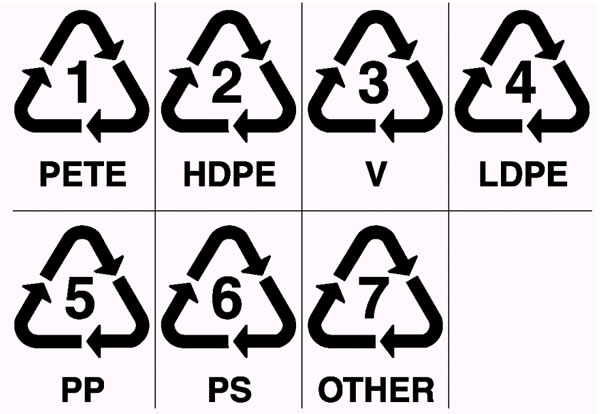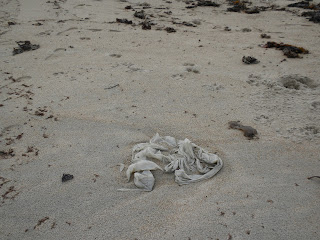Most of the man-made debris that washes up at Bay View beach is plastic. The reason is simple.
Look at this.
 |
| from http://crossplastics.com/domestic_recycling_symbols.shtml |
Sadly, it's not true. Because of this.
 |
| From http://www.fda.gov/Food/FoodIngredientsPackaging/ FoodContactSubstancesFCS/UCM155197 |
Why? Contamination. Take your #1 plastic juice bottle. #1 plastic is the sturdiest and most easy/cheap to fully recycle.* Yet to recycle one into another food-grade #1 plastic bottle requires:
- Separating out all other plastics before remelting. One stray #6 plastic out of 1,000 is enough to contaminate the lot.
- Cleaning the plastic to remove all food/waste/oil/toxin residue.
- Sorting all the strains of #1 plastic to avoid contamination.
- Running the cleaned material through the FDA's gauntlet.
- Finally, finding a distributor willing to buy the expensive product.
 |
| Row upon row of plastic |
2.54 million tons of virgin #1 plastic are made each year in the U.S. alone. In 2009, the world's largest #1 bottle-to-bottle recycler opened in Spartanburg, SC. One day it may turn 50,000 tons of #1 plastic back into food-grade recycled material. That's two percent. If we're lucky.
What happens to the rest? Downgraded, downcycled into junkier items, ultimately landfilled. And new, virgin #1 plastic must be created to keep up with the demand.
Take a different plastic, #4 film. The stuff in grocery bags. In 2008, the U.S. produced 7 billion lb. of #4 plastic. Even after 20 years of recycling initiatives, only 12% was recycled. Worse, only 4% of that 12% actually gets turned back into any kind of new film.
 |
| image copyright: American Chemistry Council http://www.americanchemistry.com |
 |
| Grocery bag on the beach |
**************************************
The story is the same from #1 to #7. The vast majority of plastics can only be recycled once, maybe twice, before becoming worthless. What's stocking the aisles of your grocery store, big-box retailer, etc.? Almost all virgin plastic.*** Almost every bottle you recycle? Replaced by another virgin-plastic bottle, which is added to an already overloaded world.
There's hype about plastic recycling. And then there's the truth: Every year, the U.S. plastic industry adds 50 million tons of new plastic to the world. The only way that plastic will die is in the fires of an incinerator. The only way.
So when you dutifully place that milk bottle or HandiSnacks wrapper in the recycling bin, remember, it's almost certainly going on a one-way trip. It will, one way or another, either end up in a landfill, or your local stream, or the ocean, before it is done.
 |
| Just look down, you'll find it |
Because the triangle is a lie.
* Though generally considered safe, it's also
** The American Chemistry Council loves to talk up the value of plastic recycling. Look for their symbol on many recycling Web sites. Also look for them as sponsors of recycling initiatives nationwide. But their own fact sheets dispell the myth. 50+% of recycled #4 plastic was sold to developing nations in 2008. Many have much lower standards for their plastics and permit very contaminated plastics to be melted together and used in food packaging. Each grocery bag you recycle may be poisoning a family somewhere on the other side of the world.
*** Don't believe the spin that this is from the waste by-products of oil refining. It's made from the same kinds of natural gas that are being harnessed and used as energy the world over. It could find a perfectly good non-plastic life.
Harry,
ReplyDeleteI really appreciate the educational nature of this blog, it's a gold mine.
I was contacted by a company in New England yesterday, asking if I still had any float rope (Polypropylene) to get rid of. They wanted to ship it to China and Vietnam for "disposal". I was proud to let them know that, even though "disposing" of 2 million pounds of PP is a tall order, we were able to use a million pounds of it as aggregate (in chipped form) for Plas-krete (tm) jersey barriers made in Massachusetts; and another million pounds are being woven into doormats as we speak -- a value-added product (see gomlf.org).
I feel strongly that the consumer holds the answers. Choose what you buy or obtain very carefully, with an eye to the end of its life. Plastic is forever. (Maybe they ought to make wedding rings out of it?)
I love it! That visual of a shimmering plastic wedding ring -- it's perfect. Of all the plastic pollution/litter blogs & stories I've read, I never saw that connection before. And it's perfect!
ReplyDeleteYou guys rock. I can't believe you managed to turn 2 million lbs into things that are actually useful (and beautiful with the doormats... maybe not the jersey barriers??). I've checked out some of the Web sites of "recyclers" in China, South Korea, and India. It makes me shudder a bit. I agree, ultimately our choices as consumers will drive the market. Sadly there are very big interests who are trying very hard to make sure we stay uninformed.
It's so hard to understand the integral role packaging has to play in marketing and selling your product.
ReplyDeleteAnother of the difficulties in wading through the truth of recycling -- and the plastics industry -- is the huge variety of terms used. "Polyolefin" is a catchall term that encompasses polyethylene (the base of #1, #2, and #4) and polypropylene (#5). A newer term that gets thrown around is "polyalkene," which means the same as polyolefin.
ReplyDeleteThe "flexible foam" that you find in things like Crocs shoes or seat cushions is also a kind of polyolefin. Want some fun? Do a Wikipedia search on polyolefin, and then maybe elastomer. Plastic is everywhere.
that last point about "waste products" of oil refining is so true. Its not a waste product cos
ReplyDeletea)of course it could be used as gas and not just "burnt off" as they are always saying.
b)It can be used to make plastic, a fantastic wonder product. We waste this amazing resource by making disposable itms and everlasting rubbish. DUH!!!!!
Thanks for raising it- it needs to said again and again and again
Hi Harry. I've been following you off and on for awhile. Thanks for all you're covering here for people to understand. This post is so very important for everyone to grasp. As a result of collecting endless plastics washing up on the shores of our island in Puget Sound, I've started a new venture, called Trash Backwards (TrashBackwards.com) that's addressing the problem of plastics in our environment by getting people to NOT recycle, but reuse, repurpose, give, and fix whatever they've got. The aim is to teach and share ideas with each other about how we don't even have to buy new if we can repurpose what we have in the first place. With plastics, never buying it again and re-thinking what we have to prolong its useful life seems the best solution. This, along with waste audits in schools and taking journeys to remote parts of the world, like Nepal, to live and film amongst cultures that reuse every last bit of what they've got has been the best ideas we can come up with to share and educate others about new ways of rethinking our relationship with the material culture that defines us.
ReplyDeleteThanks for all you're doing.
Liesl
www.TrashBackwards.com
What a brilliant website & idea! Make the concept real & present. It's so frustrating that 40 years after plastic "recycling" first began it's both so poor and so mis-labeled. Time to change the game and rethink.
DeleteThat’s a nice site you people are carrying out there.auto insurance
ReplyDeleteThanks for your beyond belief blogs stuff.what will full coverage insurance pay for
ReplyDeleteI guess this blog is perfectly incomparable.pay day lenders
ReplyDeletePersonally I think overjoyed I discovered the blogs. pay day loan
ReplyDeleteI read a article under the same title some time ago, but this articles quality is much, much better. How you do this.. university of melbourn
ReplyDeletePlastic has also become an integral part of life on a day to day basis. Getting rid of plastic has become an increasingly challenging task. Plastic recycling consists of several processes through which plastic waste is collected and converted back into new raw materials, instead of being simply disposed of.
ReplyDeletePlastic Recycling in dubai